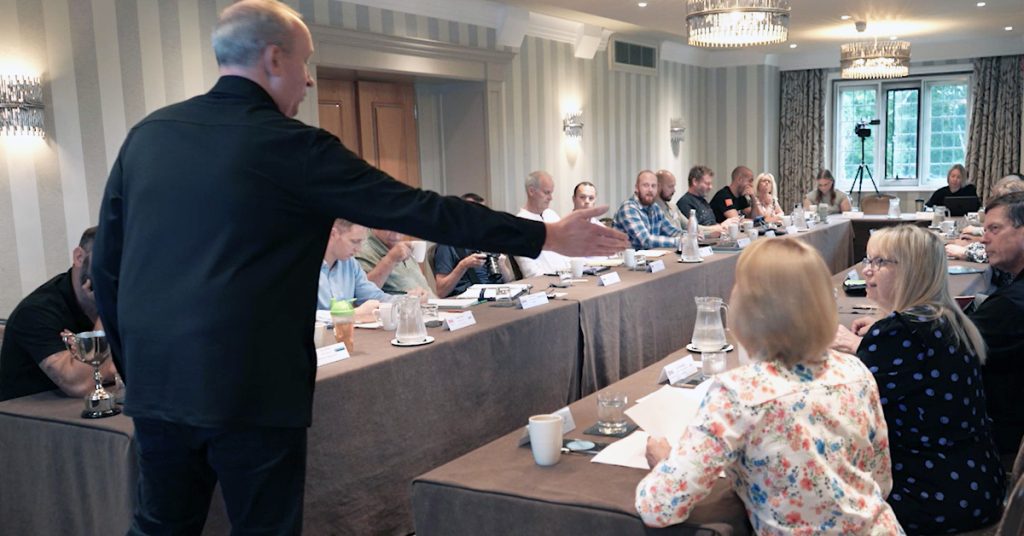In a recent BNI Education Slot, Darren Jamieson tackled a subject that every member encounters but few take the time to master: writing testimonials. Too often, testimonials are written with little thought, simply to earn points on the BNI traffic lights. Darren reminded the room that the real purpose of a testimonial goes much further. It is about elevating your fellow members, helping them demonstrate their expertise, and providing material they can proudly use in their marketing.
Why Testimonials Matter
According to Darren, testimonials are not for you, they are for the member you are supporting. A well-written testimonial can become a piece of promotional content that drives credibility and attracts new clients. Whether it is used on social media, added to a website, or shared in a proposal, a testimonial can give potential customers the confidence to buy.
Unfortunately, many members settle for writing something simple like “They did a great job” or “Highly recommended.” While well-meaning, these short comments lack impact and do little to help the recipient. Darren challenged members to think differently and to write testimonials as stories.
Facts Tell, Stories Sell
In marketing, there is a saying: “facts tell, stories sell.” Darren applied this directly to testimonials. A story draws people in, makes the testimonial memorable, and shows the true value of what the member delivered.
Every story, Darren explained, needs three characters:
The Hero – This is always the member you are writing about. They are the one who comes to the rescue and solves the problem.
The Damsel in Distress – This could be you, if you personally used the member, or the client you referred. They are the one who faced the problem.
The Villain – This does not have to be a person. It could be a situation or obstacle, such as a flooded house, a broken car, or a technical challenge that needed urgent attention.
By casting the member as the hero and framing the testimonial around how they saved the day, you create a compelling narrative that goes beyond a generic thank you.
The Structure of a Great Testimonial
Darren then broke down the framework for writing an effective testimonial:
• Start with a headline. This is your opening line and should grab attention by celebrating the success. For example: “Paul Murray saved the day when my insurance crisis struck.”
• Explain the problem. Set the scene by describing the challenge or difficulty (the villain). This gives context and makes the hero’s actions stand out.
• Tell the saviour story. Describe what the member did, how they solved the problem, and what the outcome was. This is the heart of the testimonial.
• Finish with a recommendation. Conclude by telling others what you suggest they do: “If you ever face this problem, I highly recommend calling Paul.”
By following this simple narrative arc, your testimonial becomes not only useful but also engaging, persuasive, and marketable.
Making Testimonials Easy
For members who feel daunted by the idea of writing stories, Darren offered a practical suggestion: use AI. Tools like ChatGPT can take the facts of what happened and help draft a testimonial in the right structure. This ensures that even if writing is not your strength, you can still provide high-quality feedback for your fellow members.
The Bigger Picture
Ultimately, Darren’s message was that testimonials are a gift. They are a way of giving back to your fellow members, supporting their businesses, and reinforcing the culture of referrals within BNI. By taking a little more time to write them well, you contribute to a stronger chapter where everyone benefits from better marketing and stronger reputations.
As Darren concluded, a great testimonial is not about earning points. It is about helping your fellow members grow their businesses, win more clients, and shine as the heroes of their own stories.
Full Transcript
[00:00]
Darren: I’ve been asked today to do an education slot on testimonials. Someone’s getting picked on for testimonials and the reasons why we do them. But no, not the reasons why we do them.
[00:28]
Darren: It’s about how to write a cracking testimonial. Because testimonials aren’t just for points, are they Stephen?
Stephen: No.
Darren: No. You don’t just do it to get the five points on the traffic lights, do you, Stephen? No. No. Why do you do a testimonial? Hypothetical question. You don’t need to answer that. We do a testimonial because we want to elevate the other member so they can use it in their marketing. It’s not for points.
[00:47]
Darren: It’s not just to say we’ve done it. It’s not to stop me badgering Stephen every single week on not having done a testimonial. Maybe today’s the day. I don’t know. It’s not apparent. No, it’s not. It’s to help the other member in their marketing. So if you’re going to do a testimonial for someone, they should be able to use it to promote their business.
[01:07]
Darren: They should be able to use it on social media. They should be able to use it to get more clients. So, if you do a testimonial that just says, “Oh, Dave did some carpets for me. They were really good. Thank you, Dave. Brilliant.” That’s not much of a testimonial, is it?
There’s an old adage in marketing: facts tell, stories sell. Exactly.
[01:31]
Darren: So if you want to do a great testimonial, you want to craft it as a story, as a narrative. And every good story needs a hero. It needs a damsel in distress and it needs a villain.
So your testimonial should have a hero. And the hero of your testimonial is the person you are giving the testimonial to. They are the saviour. They are the person you’re bigging up. Not yourself. Them. Make it all about them.
[01:58]
Darren: What great thing did they do? What superpower did they have? How did they save the damsel in distress? And who is the damsel in distress? That’s the person who gave the referral. It might be you if it was an internal referral or it might be the person you referred them to.
[02:22]
Darren: And then it needs a villain. Now the villain doesn’t have to be a physical person. It can be a situation. The villain could be: ah, my house is flooded and I needed somebody to sort out my insurance. And that was Paul Murray. By the way, if your house is flooded, it’s too late to sort out your insurance. But you get the point.
[02:41]
Darren: It might be, oh, I crashed my car and ran over somebody on a quad bike.
Audience: It’s just all about me.
Darren: Oh, yeah, actually, yeah. Sorry to bring it all back to you. It has all gone wrong for Zoe, has it? Let’s move off Zoe.
[03:00]
Darren: It might be, I’ve just bought a really expensive puff and need it… oh, sorry, that’s you again. Get your villain sorted for your story.
So, how do you actually structure your testimonial? How do you structure a narrative? Well, you could use AI. You could use ChatGPT and do it. Just give it the facts and it will do it.
[03:19]
Darren: But the way you want to structure it is your headline. Your opening should be the success that you have. “Joe Fitty saved the day” or “Paul Murray swept in like a hero” or whatever it may be.
Opening line: give the headline of what the story is, of what the hero actually did. Then you go into the situation, the problem, what happened, what despair you were in, what devastating occurrence happened.
[03:50]
Darren: You then move on to the saviour story about how it was saved – the solution – before going on finally to your recommendation. What do you suggest other people do in this situation?
And that gives you the structure of your testimonial: headline, problem with your villain and damsel, how it was saved and solved, what you would recommend somebody else does.
[04:17]
Darren: Keep it to one side of A4. That way you’re back. Sorry, Stephen, that’s a villain. You need a chiropractor who will be the hero of your story. Never mind, we haven’t got one in this chapter.
That is how you construct a testimonial that is going to help somebody else use it in their marketing, to promote their business, and to get more clients for themselves.
[04:42]
Darren: Again, if you think “I can’t do all of that, I don’t know how to write a story,” just ask ChatGPT and it’ll do it for you and everything will be fine.
Thank you very much. I expect to see a testimonial from you for somebody next week.
Audience: You could be upset.
Darren: I could be upset. Well, actually, I’m not here to do it next week. I hope you don’t do it next week.
[05:00]
Darren: I might do it now. Come on, thwart me and do it next week. Thank you very much.



 Subscribe for the latest BNI Education Slots
Subscribe for the latest BNI Education Slots